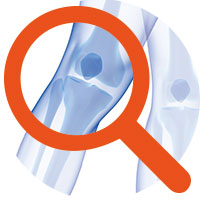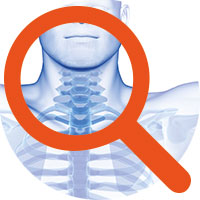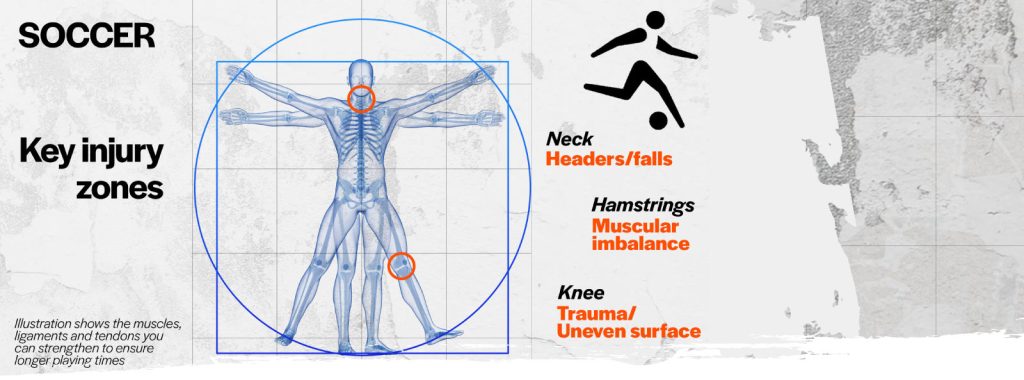Soccer is undeniably catchy, doesn’t require much kit and has pretty straightforward rules, characteristics which make it a very inclusive sport for every background. No matter who you are or where you come from, you can become great at soccer!
Those are reasons soccer is the most widespread sport in the world, by both number of fans and by people who play it at any level. There is a big chance that you are now stuck at home, unable to play with your soccer team and that must be really annoying!
Much loved as soccer is, it ranks pretty high in the incidence of injuries chart*. Let’s find out together what the most likely ones are and why they occur.

Hamstrings
Hamstrings are the whole “back” of your leg and go from glute to knee. They are meant to be the strongest muscle in your leg, followed by the quadriceps at the front (the thigh, basically)**. Unfortunately soccer inverts this delicate balance and over time legs of soccer players become heavily quadriceps dominant. This is caused by repeated kicking (which is a 100% quadriceps movement) and slow running, which represents the vast majority of moving around a soccer pitch. Slow running is not powerful enough to engage the hamstrings, and with time, they become smaller, tight and therefore very prone to injuries***.
Knees (ACL) – Anterior Cruciate Ligament
A particularly severe damage that can afflict the knee is the tearing of the ACL. It is a ligament (a string) that binds the upper bone of your leg to the lower one, together with the PCL, forming a cross (hence the name). Its function is keeping the knee tight. Since soccer is an outdoor sport the terrain is hardly ever even, and potholes, mud, uneven grass are constantly testing your knee stability. In addition to that, soccer tackles often bring your opponent’s boots very close to your knee area ….

Neck
It might not seem very soccer related, but the stats are clear about it**. The main causes of stress are headers. Every time you fall on the ground your cervical tract of the spine moves in an uncontrolled, jerky way (particularly true for goal keepers). We need to remember that muscles aren’t particularly strong in our neck. They are excellent with prolonged efforts, since you can keep your head up for the whole day, but when it comes to counteract or produce strong fast movements, they suffer*****.
Ok, we now know what might happen and why. Here is a bunch of drills that will help you minimise the risk of all the above.
EXERCISES:
Hamstrings
A. Lie on your back on a flat surface. Raise one leg up and increase the stretch gradually by pulling your foot down with a resistance band. Make sure that the leg in front is nice and straight before increasing the angle of the working leg. Switch leg every 60 seconds. Repeat 3 times each leg.
B. From plank, bring one foot as close as you can to the hand on the same side. Try to keep the other leg as straight as possible at the back. Switch leg every 15/20 seconds and repeat 6 times each leg.

C. To strengthen you hamstrings, nothing is better than resistance band “good mornings”. Knees are soft (slightly bent but not too much), send your bum far out at the back and bend over keeping as much tension as possible through your back and abs, so that your torso is perfectly straight.
Knees
Find a relatively low and safe step to do this exercise. Start by balancing on one foot. Once you are ready and balanced, jump on the box using one leg only and hold the landing position with bent leg for 2-3 seconds, fighting to find the best balance up there as well. No need to jump down. Reset and switch legs. Perform 3 sets of 6 reps each leg.

Tie a resistance band onto something solid and put your leg through the other end of it. Try to push forward as shown in the picture with a controlled movement, and don’t let the tension of the band yank you back. Repeat 10 times each leg. 3 sets.

Neck
This is a mild stretch, but enough to make sure that your neck is ready to take all the action that soccer throws at you! Place your arm behind you, depress your shoulder, but without compromising your upright posture. Pull your neck in the opposite direction with the other arm. Hold for 45 seconds. Repeat 4 times.

References
* Carter, E. A., Westerman, B., J., Hunting, K. L. (2011) ‘Risk of Injury in Basketball, Football, and Soccer Players, Ages 15 Years and Older, 2003–2007’, Journal of athletic training, 46(5), 484-488
** Watson, A., Mjaanes, J. M. (2019) ‘Soccer Injuries in children and adolescents.’, American Journal of paediatrics, 19(1), online.
*** Schache, A. G., , Dorn, T., W., Wrigley, T. V., Brown, N. A. T., Pandy, M. G. (2013) ‘Stretch and activation of the human biarticular hamstrings across a range of running speeds.’, European Journal of appliend physiology, 113(11), 2813-2828
**** Ratamess, N. (2012) Foundations of Strength training and Conditioning. Indianapolis: Lippincott, Williams and Wilkins
***** Tucker, L. (2015) An introductory guide to anatomy and physiology 5th edn. London: EMS Publishing






